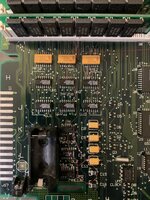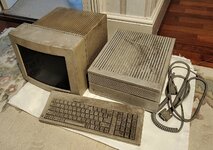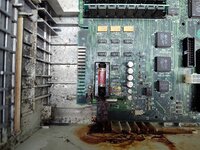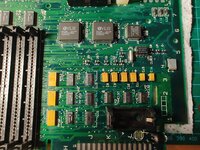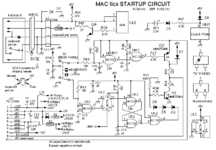Hi All,
Trying to coax a IIcx back to life and figured I'm come to the group if anyone has any suggestion.
For some background, this machine had an extreme case of leaky capacitors with corrosion mainly focused in the area of the startup circuit. After an initial recap of the entire board, the machine was basically dead. For additional context, the power switch on the board activated the PSU, but that was it, couldn't even turn the machine off without directly pulling the plug.
From there I started digging into the schematics and unsurprisingly found a slew of broken traces in the startup circuit area. I ended up lifting every chip, cleaning under the board and fixing every trace and pad that was barely hanging on. After hand-wiring at least half of the connections for the mux chips and ram address lines, still no chime, but perhaps marginal success in that the startup circuit now appeared to be functioning correctly (I can turn the machine on and off with the switch and soft power works as well).
Moving on from that area of the board, I went to known culprits for this family of machines; Checked the sony sound chips. Continuity was there on the reset lines and other connections. One chip had a little oxidation so I lifted it to see if anything underneath needed attention, but it was fine, so I just cleaned everything and slapped it back on.
Additionally, I've tried to rule out the dumb stuff too: Swapped known good PSU from a IIci that I have. Tested RAM in other machines, swapped RAM from working machines, PRAM battery, etc. Heck I even dropped in an SE/30 and BMOW ROM SIMM to bypass the onboard ROM. Still no change in result.
I get power on, the speaker/headphone pops with power/reset, but thats about it. I was figuring with the address lines connected again, I'd at least get a death chime to try and investigate any other errors that might exist. Can you expect power on/off to 'work' and nothing else happen if one of these logic chips are bad?
So here I am now, sort of just guessing, and I'm hoping that someone may have encountered this or something similar with a IIcx and could offer any suggestions. I have also admit that I'm sort of limited with equipment for further chip-level testing at the moment with the lack of an oscilloscope, but maybe there's something else that I'm just overlooking to try and advance this thing a little further. Any recommendations are much appreciated.
TL;DR:
-Kris
If anyone's curious, attached is the repair on the area for the startup circuit/RAM/ROM line.
Trying to coax a IIcx back to life and figured I'm come to the group if anyone has any suggestion.
For some background, this machine had an extreme case of leaky capacitors with corrosion mainly focused in the area of the startup circuit. After an initial recap of the entire board, the machine was basically dead. For additional context, the power switch on the board activated the PSU, but that was it, couldn't even turn the machine off without directly pulling the plug.
From there I started digging into the schematics and unsurprisingly found a slew of broken traces in the startup circuit area. I ended up lifting every chip, cleaning under the board and fixing every trace and pad that was barely hanging on. After hand-wiring at least half of the connections for the mux chips and ram address lines, still no chime, but perhaps marginal success in that the startup circuit now appeared to be functioning correctly (I can turn the machine on and off with the switch and soft power works as well).
Moving on from that area of the board, I went to known culprits for this family of machines; Checked the sony sound chips. Continuity was there on the reset lines and other connections. One chip had a little oxidation so I lifted it to see if anything underneath needed attention, but it was fine, so I just cleaned everything and slapped it back on.
Additionally, I've tried to rule out the dumb stuff too: Swapped known good PSU from a IIci that I have. Tested RAM in other machines, swapped RAM from working machines, PRAM battery, etc. Heck I even dropped in an SE/30 and BMOW ROM SIMM to bypass the onboard ROM. Still no change in result.
I get power on, the speaker/headphone pops with power/reset, but thats about it. I was figuring with the address lines connected again, I'd at least get a death chime to try and investigate any other errors that might exist. Can you expect power on/off to 'work' and nothing else happen if one of these logic chips are bad?
So here I am now, sort of just guessing, and I'm hoping that someone may have encountered this or something similar with a IIcx and could offer any suggestions. I have also admit that I'm sort of limited with equipment for further chip-level testing at the moment with the lack of an oscilloscope, but maybe there's something else that I'm just overlooking to try and advance this thing a little further. Any recommendations are much appreciated.
TL;DR:
- Recapped the board
- Thorough cleaning
- Re-wired startup circuit
- Corrected other obvious spots
- Machine still dead. Need help. Thank you in advance.
-Kris
If anyone's curious, attached is the repair on the area for the startup circuit/RAM/ROM line.

